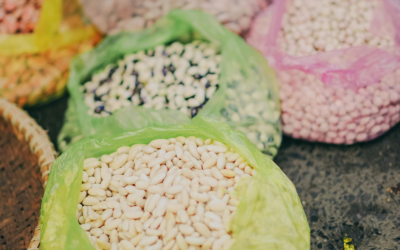What is the Low FODMAP Diet?
The low FODMAP diet is an increasingly popular food-based intervention for IBS patients who suffer from abdominal pain proceeding from bowel movement, followed by irregular stool form and/or frequency. The term “FODMAP” stands for Fermentable Oligosaccharides Disaccharides Monosaccharides and Polyols. These are known as short chain carbohydrates that are found in a majority of the foods that we consume on a daily basis2. The Academy of Nutrition and Dietetics states that these carbohydrates can be poorly absorbed in the intestine, may draw extra water into the intestine and are fermented quickly by bacteria in the gut causing symptoms such as gas and bloating2.
The diet starts with an “elimination period” where all foods that are high in FODMAPs are eliminated completely from the diet. This phase can last around 2-6 weeks – though this period can change person to person. After the elimination period ends, with the guidance of a dietitian, you will begin the” re-introductory period” which slowly brings back each type of FODMAP into your diet again to see how your body reacts. It is important to keep track of how your body reacts to each new food that you try. Throughout the elimination and re-introductory period it is recommended that you keep a food diary and write down signs and symptoms of gastrointestinal stress in order to identify your trigger foods.
Examples of Each FODMAP
- Oligosaccharides
Oligosaccharides (fructans and galactans) are found in fruits such as apples, currants, nectarine, peaches, persimmon, and watermelon. Some vegetables that contain oligosaccharides are artichokes, garlic, onions, shallots, leeks, onion & garlic salt and powders. Oligosaccharides are also found in legumes such as borlotti, fava, red kidney beans, soybeans, and some soy milks, silken tofu, and split peas. Lastly, this is also found in grains such as rye wheat and barley2. - Disaccharides
The three most common types of disaccharides are sucrose, lactose, and maltose. Foods that contain lactose are milk, evaporated milk, yogurt, ice cream, custard, ricotta, cottage and mascarpone cheese. - Monosaccharides
A monosaccharide is a simple sugar that is most commonly known in the form of glucose, fructose and galactose. These can be found in fruits like apples, bananas (ripe) boysenberries, cherries, figs, mangos, pears, watermelon. They can also be found in vegetables such as artichokes, asparagus, and sugar snap peas. Sweeteners such as agave, honey, and High Fructose Corn Syrup all contain fructose as well. Lastly, monosaccharides can be found in alcohol such as rum. - Polyols
The three most important polysaccharides are starch, glycogen and cellulose which are all made from the monosaccharide, glucose. Polyols can be found in fruits like apples, apricots, blackberries, cherries, nectarines, pears, peaches, plums, prunes and watermelon. . They are also found in specific vegetables such as cauliflower, mushrooms, and snow peas. . Lastly, they are present in sweeteners ending in -ol such as sorbitol, mannitol, maltitol, isomalt, and xylitol2. These can be found in sugar free gum, mints, cough drops and some medications.
Tips on maintaining a low FODMAP diet
It is important to figure out what specific foods and eating habits worsen your discomfort when you have irritable bowel syndrome. Simple changes can eliminate or alleviate the pain. Many have reported that having regular bowel movements reduce frequent flare ups1. This can become achievable if you schedule to eat meals and snacks at the same time everyday1. It is also important to make sure that you are consuming fiber-rich foods. If you have not eaten fiber-rich foods in the past, make sure to slowly introduce them into your diet, otherwise it will further exacerbate symptoms such as bloating and gas1. Another tip to help IBS patients reduce symptoms is by eating small frequent meals instead of large meals1. This helps relieve the GI tract from overworking all the time. Lastly, it is crucial to drink enough water throughout the day1. This will help the foods you consume to move smoothly throughout the intestine.
How can a registered dietitian help me with a low FODMAP diet?
Working one-on-one with a dietitian is essential in the success of implementing the low FODMAP diet. It can be extremely overwhelming to look at all of the rules and food lists – this is why many don’t want to try it to begin with. When you work with a dietitian, s/he can help the patient reintroduce certain types of foods that contain FODMAPs. This will help identify what foods worsen your IBS symptoms. A registered dietitian can help reduce the stress in managing IBS discomfort by creating individualized:
- Guide(s) on what foods you CAN consume
- Low FODMAP grocery list(s)
- High & low FODMAP list
- Reintroduce FODMAPs back into diet while monitoring IBS symptoms
- Meal suggestions that suit your taste preferences
- Action plan to create a balanced diet
- Answering questions and concerns
After you complete the low FODMAP diet, it becomes much easier to manage the pain IBS patients experience. The low FODMAP diet identifies your individualized “trigger” foods and how to eliminate them from your diet while still living a healthy balanced lifestyle. It’s important to note that patients should not stay on a low FODMAP diet forever. Staying on this type of diet could lead to nutritional deficiencies as well as a decreased intake of fiber. The overall goal is to target foods that cause IBS symptoms while also learning how to have a diverse diet – and love what you eat!
If you have any more questions or concerns regarding the low FODMAP diet or would like to try it, talk to a Health Loft dietitian in Chicago, IL (in person or virtually via our telehealth platform) or in other regions of the United States (virtually via our telehealth platform) by calling us at (312) 374-5399 or by scheduling an appointment online. For more tips and fun facts to also check out our Facebook, Instagram, and Twitter pages for more articles on nutrition, physical therapy, and exercise!
REFERENCES
-
-
- Ellis, R. (2019, August 29). Irritable Bowel Syndrome. Retrieved September 01, 2020, from https://www.eatright.org/health/wellness/digestive-health /irritable-bowel-syndrome
- King, K. (2020, August 10). What Is the Low FODMAP Diet. Retrieved September 01, 2020, from https://www.eatright.org/health/allergies-and-intolerances /food-intolerances-and-sensitivities/what-is-the-low-fodmap-diet
-










